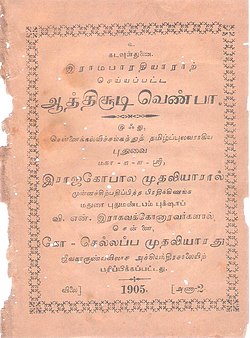


VenpaorVenba (வெண்பாinTamil) is a form of classical Tamil poetry. Classical Tamil poetry has been classified based upon the rules of metric prosody.[1] Such rules form a context-free grammar. Every venba consists of between two and twelve lines. The venpa meter is used in songs of the types neṭu veṇ pāṭṭu ('long song in venpa meter'), kuṟu veṇ pāṭṭu 'short song in venpa meter', kaikkiḷai "one-sided love," and paripāṭṭu 'song that is quite accommodative' and in satirical compositions (aṅkatac ceyyuḷ).[2]
•Vowels and consonant-vowel compounds(such as ka, kā, ki, kī) in Tamil alphabet have been classified into ones with short sounds (kuril) and the ones with longer sounds (nedil).
• Asai(Acai): Vowels and such vowel-consonant compound/s optionally followed by a consonant is known as asai(lit. move). The Tamil word asai roughly corresponds to syllable/a group of syllables. Asai is of two types - Nēr(lit. linear/straightforward) asai and Nirai(lit.waves) asai.
•Sīrorcīr: Sīr is the metrical foot in Tamil poetry.
•Thalai(lit. binding): The juxtaposition of metrical foot patterns.
Note that the official terms for the different "asai"s are self-descriptive. For example, the word "ner" is itself classified as ner asai. And the word "nirai" is a nirai asai.
A set of well defined metric rules define the grammar for venba. Such rules have been proved to form a context-free grammar.[3]
One set of rules constrains the duration of sound for each word or cīr, while another set of rules defines the rules for the possible sounds at the beginning of a word that follows a given sound at the end of the preceding word. Any venbā should conform to both these sets of rules.
Following is the set of production rules corresponding to the first set of rules.
<VENBAA> → <ADI>{1-11} <EETRADI>
<ADI> → <CHEER> <CHEER> <CHEER> <CHEER>
<EETRADI> → <CHEER> <CHEER> <EETRU CHEER>
<CHEER> → <EERASAI>| <MOOVASAI>
<EETRU CHEER> → <NAAL>| <MALAR>| <KAASU>| <PIRAPPU>
<EERASAI> → <THEMAA>| <PULIMAA>| <KARUVILAM>| <KOOVILAM>
<MOOVASAI> → <THEMAANGAAI>| <PULIMAANGAAI>| <KOOVILANGAAI>| <KARUVILANGAAI>
<THEMAA> → <NER> <NER>
<PULIMAA> → <NIRAI> <NER>
<KARUVILAM> → <NIRAI> <NIRAI>
<KOOVILAM> → <NER> <NIRAI>
<THEMAANGAAI> → <THEMAA> <NER>
<PULIMAANGAAI> → <PULIMAA> <NER>
<KARUVILANGAAI> → <KARUVILAM> <NER>
<KOOVILANGAAI> → <KOOVILAM> <NER>
<NAAL> → <NER>
<MALAR> → <NIRAI>
<KAASU> → <NER> <NER>
<PIRAPPU> → <NIRAI> <NER>
<NER> → <KURIL>| <NEDIL>| <NER> <OTRU>
<NIRAI> → <KURIL> <KURIL>| <KURIL> <NEDIL>| <NIRAI> <OTRU>
<KURIL> → {VOWELS OR COMPOUNDS WITH A SHORT SOUND}
<NEDIL> → {VOWELS OR COMPOUNDS WITH A LONG SOUND}
<OTRU> → {CONSONANTS, WHICH HAVE AN EXTREMELY SHORT SOUND}
1. {1-11} is not a standard BNF notation but a widely accepted EBNF notation indicating
repetition of number of times specified in the range.
2. The grammar has some redundant productions that have been retained so as to preserve
the semantics as described originally in Tamil grammar.
Following is the set of production rules corresponding to the second set of rules.
<VENBAA> → <X>| <Y> <X> → <THEMAA> <Y> <X> → <KOOVILAM> <X> <Y> → <PULIMAA> <Y> <Y> → <KARUVILAM> <X> <X> → <NAAL>| <KAASU> <Y> → <MALAR>| <PIRAPPU> [If the above rules are conformed to, the thalai is said to be Iyarcheer vendalai] <X> → <THEMAANGAAI> <X> <X> → <KOOVILAANGAAI> <X> <Y> → <PULIMAANGAAI> <X> <Y> → <KARUVILANGAAI> <X> [If the above rules are conformed to, the thalai is said to be Vencheer vendalai]
Following is a couplet from Tirukkural:
உடுக்கை இழந்தவன் கைபோல ஆங்கே |
As hand of him whose vesture slips away, |
| —Kural 788 | —Translated by G. U. Pope[4] |
 |
 |
|
| |||||||||||||
|---|---|---|---|---|---|---|---|---|---|---|---|---|---|
| History |
| ||||||||||||
| Dialects |
| ||||||||||||
| Global organizations |
| ||||||||||||
| Literature |
| ||||||||||||
| Tamil and other languages |
| ||||||||||||
| Scripts |
| ||||||||||||
| Lexis and grammar |
| ||||||||||||
| Phonology |
| ||||||||||||
| Transliteration |
| ||||||||||||
| Events |
| ||||||||||||